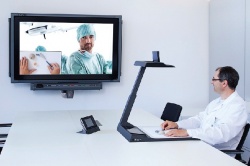Responses to six misperceptions
Responses to six misperceptions in the ‘gold rush of the 21st century’
Ageing populations, struggling healthcare systems, medical staff shortages, rising costs – all are well recognised. Thus telemedicine, dubbed the ‘gold rush of the 21st century’ earlier in the year by Jonathan D Linkous, CEO of the American Telemedicine Association (ATA), is gaining momentum.


Telemedicine can be pragmatically defined as devices and communication technology enabling ‘health systems to expand their market share and by new providers of remote health services’. In his newsletter, the ATA CEO outlined ‘six misperceptions’ in the context of telemedicine vendors and service providers staking their claims. Michael Reiter of European Hospital sought the reactions of European medical and healthcare experts to these ATA statements
Statement 1: It’s not the technology – it’s the service
‘Devices are tools that allow services to be provided at a distance,’ says Jonathan Linkous. ‘In healthcare, the focus, the purpose and the finances are on the service.’
According to George Crooks, Medical Director, NHS 24 in Scotland and Coordinator of the new large-scale telemedicine pilot ‘United4Health’ funded by the EC, ‘In Europe, the drive is for safe, effective and person-centred care. To secure these goals, while at the same time delivering affordable and sustainable health and care services, requires us to innovate. The key innovation is in service redesign, supported by technology, not the other way around!’ Moving citizens from being recipients of care to become informed providers of their own care – where it is safe and appropriate to do so – will benefit everyone, he believes.
Christian Hay, Delegate for Healthcare, GS1 Switzerland, defines telemedicine not in the restrictive sense of ‘providing healthcare services in remote conditions’, but as ‘the capacity to access healthcare-relevant information in secure, safe and appropriate manner, where this information has been produced, enriched, and stored’. Further, he raised a point regarding standards: ‘Due to the density of healthcare services in most of Europe, considerable efforts are made to standardise clinical data by using common semantics (SNOMED), minimum sets of common information, bridging identification gaps when a single standard (GS1) has not been adopted, etc.’ Processes to access clinical data – ‘safety, security, accuracy, and appropriateness’, he said, are mainly ‘considering IHE as the meta-standard way to link clinicians within a jurisdiction, as well as cross-border’.
2: Despite what you hear, Medicare reimbursement is not the Holy Grail for telemedicine.
‘Medicare fee-for-service covers about 36 million Americans ... 88 percent of Americans are covered elsewhere and 81 percent of healthcare spending comes from other sources’, according to the ATA CEO. ‘There are no federal restrictions on using telemedicine for billions of health dollars spent on managed care, bundled services and on alternative plans by private payers.’
On budgets and financing, George Crooks states that one of the barriers to adoption of any new practice in healthcare ‘is professional resistance. There are many reasons cited for this, from vested interests, discomfort at change and so on. However rather than focusing huge efforts on some of these less tangible issues, we should spend more time on developing real incentives to change and dismantling the concrete barriers. Key to this are the financial models that are in operation. Incentivise directly where appropriate, look to re-aligning or pooling budgets where benefits can be realised by those effecting the change rather than benefits being realised “somewhere else” etc.’
Christian Hay: ‘Telemedicine has been frequently positioned as a key solution to reduce healthcare costs. That has not been demonstrated up to now; but telemedicine provides a considerable increase in efficiency, which is critical since the population is growing and becoming older, and it’s already known that the number of care givers will not be sufficient in a couple of years.
3: Healthcare institutions, physicians and industry are partners not enemies.
‘Transforming does not require replacing,’ Jonathan Linkous comments. ‘So many new entrepreneurs in telemedicine start out with a negative, competitive attitude towards traditional healthcare. We have not reached the point when someone with heart disease is going to trust his or her care to a computer alone. The roles of hospitals and health providers are changing but they will continue to be the backbone of medicine.’ Health and care will always be a ‘people’ business, George Crooks commented. ‘Face-to-face care is the backbone of healthcare and will always be so. However, technology, appropriately targeted can safeguard face-to-face care for those who really need and benefit from it, by taking certain transactions away and dealing with them in a way that’s more convenient and accessible to the user.’
Collaboration is the key to future success, the medical director believes. ‘For too long, healthcare providers felt they not only had to own the problem but also build the solution. Traditional procurement models left both sides suspicious and often dissatisfied; we need to work smarter and differently together.’
4: Device regulation is not bad – it’s good.
Device regulation could rapidly accelerate adoption, Jonathan Linkous states. FDA rules for wired and mobile telemedicine devices, and their certification by an official government agency, is a stamp of approval, providing reassurance for cautious buyers. ‘Device regulation has significant advantages and should be progressed’, George Crooks agreed.
Device regulation, by deploying Unique Device Identification (UDI) across the world, will facilitate development and maintenance of interconnected implant registries, Christian Hay added. ‘The lack of registries and their small ability to interconnect has become evident with the PIP breast implants scandal a few years ago; that provided regulators with a strong impulse to progress their efforts in standardising their medical devices regulation. The EU is a little behind the USA’s FDA, but working on harmonised directions.’
Clarity around the application of medical device regulation in the area of mobile health is ‘essential in order to protect user safety, build trust and maximise effectiveness, while encouraging innovation and stimulating new deployments on the market,’ added Jeanine Vos, Executive Director, mHealth, GSMA – the GSM industry association. ‘We therefore welcome the proposed EU regulation on medical devices as an important opportunity to create this clarity and help to ensure that mobile health solutions are regulated appropriately.’
5: A great idea is born every minute but few of them are successful.
Hundreds of new applications or remote health services aimed at lower rates of hospitalisation, improved compliance, etc. have popped up, the ATA CEO points out.
George Crooks: ‘A positive study is nice, but marketing, partnerships, revenue pathways and knowledge of healthcare business practices are essential, for starters. Innovation by its very nature needs individual champions and enthusiasts, but transfer of even the most successful pilot to a main stream service and an “at scale” deployment needs the alignment of national, regional or organisational policy, strategy and business planning processes.’
6: Consumers don’t buy healthcare themselves.
For fifty years, the percentage of out-of-pocket consumer spending on healthcare has dropped (not counting insurance or co-pays), Jonathan Linkous states. ‘It is now less than ten percent of healthcare costs. Consumers are getting much more knowledgeable and engaged in selecting among available procedures and treatments, but they rarely pay directly for a healthcare product and service.
‘If you look at the NHS within the UK, where healthcare is free at the point of delivery, this is certainly true’, George Crooks commented. ‘But the drive to person-centred care makes patient choice an increasing reality.’ The expert reminds us that patients ‘pay in many different ways. For example, in lost work hours because they have to access conventional care services etc.’ – an aspect that depends on typical work contracts and regulations in individual European countries.
18.11.2013









